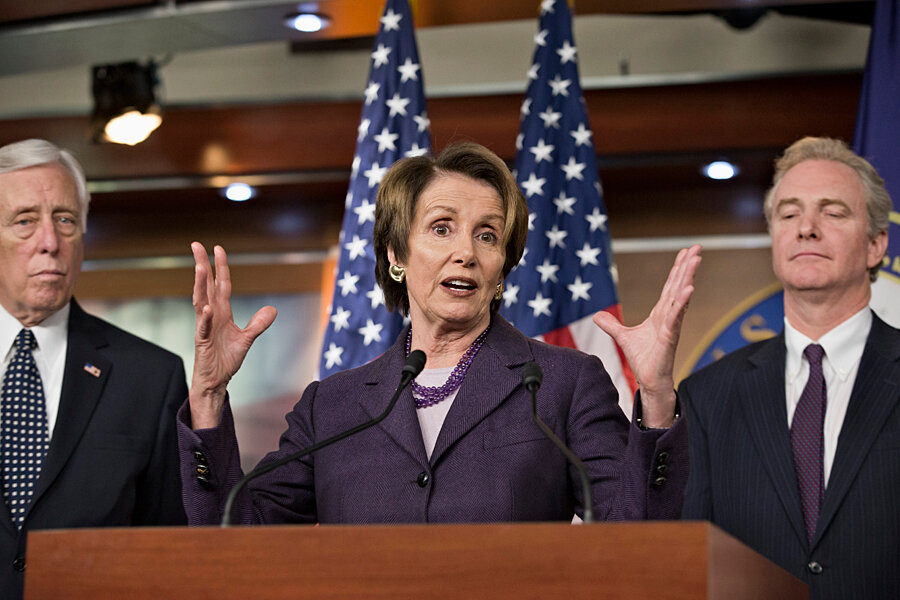Budget deal in the offing? Outlines emerge, details sketchy, support iffy.
Loading...
| Washington
Don’t exhale just yet, but it looks as if a budget deal to avert a government shutdown in January is taking shape.
The agreement is still as wiggly as Jell-O, and plenty of disagreements could cause it to slide off the plate. But after enduring the first government shutdown in 17 years, no federal budget in four years, and worse-than-dismal public approval ratings for Congress, lawmakers are eager to strike a deal as soon as next week – and then enjoy the holidays without the prospect of another budget showdown next month.
If a deal firms up and gets approved by the House and Senate, it will mark a pause, at least, in the fiscal wars that have taken a toll on Washington, the US economy, and the public since 2011. That’s when Republicans leveraged the need to raise the US debt limit to try to extract budget cuts from Democrats.
If a deal is not struck, funding to keep most government services going will run out in mid-January, and another partial shutdown would occur. Moreover, the default budget then becomes the "sequester" plan, which requires another round of automatic spending cuts. Those across-the-board cuts are unpopular with lawmakers of both parties (though for different reasons), and negotiators would dearly love to come up with an alternative – not to mention pave the way to restoring some degree of normalcy to the budget process on Capitol Hill.
“If this deal comes together … the [House and Senate] budget committees can do their work, the appropriators can do their work,” says a senior Democratic aide. “The hope is that if some trust is restored in this process,” then “a foundation can be laid” to tackle bigger issues, such as illegal immigration.
But don’t get carried away just yet. What’s taking shape is a narrow agreement. It doesn’t touch the most expensive part of the federal budget, spending on entitlement programs such as Medicare and Social Security. It doesn’t reform the tax code – a hot topic in Washington. And it does not wrap in any agreement on raising the national debt limit when it hits the ceiling again next year.
The emerging deal, as described so far, indicates that the chief budgeteers – Sen. Patty Murray (D) of Washington and Rep. Paul Ryan (R) of Wisconsin – seek to soften only some of the automatic cuts with a two-year agreement, meaning that cuts to the military and some domestic programs would not be so deep for fiscal years 2014 and 2015. The annual budget would total about $1 trillion – $33 billion more in spending for fiscal 2014 than what would occur under the next round of sequester cuts.
Ms. Murray and Mr. Ryan reportedly want to offset that $33 billion, and to shrink the budget deficit, with a series of other cuts over 10 years and revenue raised by fees. Cutting Saturday postal service, restructuring pensions for federal workers, and raising fees for air travel are among the measures apparently under discussion.
But some House Democrats scowled Thursday upon some of these ideas, and their support for the final budget package will be crucial. That's because the most conservative House Republicans would likely balk at any higher spending level than the sequester-set level and any notion of fee increases, so Democratic votes would be needed to approve the compromise deal. Indeed, a group of at least 18 House Republicans has already objected to these very issues in a letter to House Speaker John Boehner (R) of Ohio.
House minority leader Nancy Pelosi on Thursday insisted that, as part of a budget agreement, jobless benefits for the long-term unemployed – affecting 1.3 million people – be extended when they expire at the end of December. And House minority whip Steny Hoyer said he wants “a big deal,” not a small one, citing the need for investment in the economy, infrastructure, and jobless benefits. He warned against playing with the pensions of federal workers, who have already sacrificed because of the partial shutdown and furloughs.
In the end, what will drive this agreement is lawmakers' desire to avoid another shutdown crisis – and they have until Jan. 15 to do that. So far, there's not much evidence that either side is gunning for another fiscal brawl.








